SEO
Google Analytics 4 Should Trigger Reorganizations & Agency Reviews
By now, you may already know that GA4 operates across platforms, uses an event-based data model to deliver user-centric measurement, and does not rely exclusively on cookies.
And you recognize that GA4 uses machine learning to generate sophisticated predictive insights about user behavior and conversions, create new audiences of users likely to purchase or churn, and automatically surface critical insights to improve your marketing.
Heck, you may have already started to move to GA4 as soon as possible to build the necessary historical data before Universal Analytics (UA) stops processing new hits on July 1, 2023, and UA 360 stops new hit processing on Oct. 1, 2023.
Many people may mistakenly think they have a good bead on things.
Well, I was at Pubcon Las Vegas on Nov. 14, 2005, when Google announced that Urchin Software, which it had acquired in April of that year, was being renamed Google Analytics. Yep, I was in the room where it happened.
I was standing next to one of my clients, John Marshall, the CEO of ClickTracks Analytics, which offered a range of competing solutions that cost $495, $1,195, or $3,495.
That’s when we both heard that the basic version of Google Analytics was free for the first time.
So, I know a little something about the impact of new versions of Google’s web analytics service.
And, I’ve learned that you don’t need to wait for machine learning to generate sophisticated predictive insights about a couple of “events” that the adoption of GA4 is likely to trigger for your organization or clients in the next 14 months.
One is a reorganization. The other is an agency review.
The Reorg
The “web analytics” team still sits in the IT department in far too many organizations.
Why?
Because the team was originally created back in 1995 when web analytics meant servers, log files, and complex handwritten code to parse the log files and pump out reports.
So, putting them in the IT department made perfect sense back then.
But, data collection, storage, and processing have all moved into the cloud (hosted by your application service provider rather than in-house).
This eliminated the need to maintain IT teams for web analytics, except perhaps to update measurement codes and related code fragments collectively known as “tags” on your website or mobile app.
In addition, your website itself has transformed from being “brochure-ware” back in the early days into an increasingly integral part of your business – both online and offline.
Nothing highlights this change more than the fact that we no longer count the number of client requests (or hits) made to the web server like they did a generation ago.
Because of these trends, the “digital analytics” team doesn’t belong in IT anymore.
Where does it belong?
Well, ask yourself three questions:
Who uses analytics?
Marketing (not IT) needs to see unified customer journeys across their websites and apps.
Marketing (not IT) needs to use Google’s machine learning technology to the surface and predict new insights.
And marketing (not IT) needs to keep up with evolving customer needs and expectations.
Who directs implementation?
Marketing (not IT) needs to decide which recommended events to add, which suggested audiences to use, and which events to mark as conversions.
Marketing (not IT) needs to decide what associate monetary values to use for micro-conversions, custom insights to create, and anomalies to act on.
And marketing (not IT) should decide which other platforms, such as Google Ads, Search Console, and Salesforce Marketing Cloud, to integrate with GA4.
Who owns reporting?
Marketing (not IT) needs to drive sales or app installs, generate leads, or connect online and offline customer engagement.
So, marketing (not IT) needs to use data-driven attribution to analyze the full impact of their latest campaigns and ongoing programs across the customer journey.
And marketing (not IT) needs to export that analysis to Google Ads and the Google Marketing Platform’s media tools to optimize those campaigns and programs.
This is why digital analytics belongs in marketing – and it has belonged there for more than 10 years.
But, inertia is a powerful force – and most people hate reorgs – which explains why far too many organizations are loath to move their analytics team out of IT and into marketing.
So, why do I think that GA4 will be the irresistible force to overcome this immovable object?
Well, one of the features that you’ve already heard about is Analytics Intelligence, which uses machine learning and conditions that you need to configure to help you understand and act on your GA4 data.
And one of the statistical techniques that Analytics Intelligence uses is Anomaly detection.
Using historical data, Analytics Intelligence “learns” to predict the value of metrics for the current time period and flags any data points as anomalies if their actual value falls outside a “credible” interval.
For detection of weekly anomalies, the training period for GA4’s machine learning is 32 weeks.
For detection of daily anomalies, the training period is 90 days. And for the detection of hourly anomalies, the training period is two weeks.
In other words, somewhere between 2 and 32 weeks after GA4 is set up and starts collecting data, Analytics Intelligence’s machine learning will be sufficiently trained to analyze your data and predict future actions that your end-users may take.
That’s when marketers will begin seeing “Insights” appear on their GA4 Home page.
These Insights will show unusual changes, emerging trends, and other anomalies about your site or app.
Seeing specific Insights can help you quickly identify data changes that warrant further analysis and action.
That’s when the marketing department will start “freaking out” if the IT department doesn’t respond to urgent requests for “help” within a week, a day, or even an hour.
And that’s when the business case for moving the analytics team from IT to Marketing will suddenly become data-driven.
Why is this scenario likely to ripple across organizations worldwide over the next 14 months?
Well, early adopters of GA4 have already reported the benefits of getting a complete view of their customer lifecycle with an event-based measurement model that isn’t fragmented by platform or organized into independent sessions.
And I’d argue that the same benefits are available to an organization that isn’t fragmented by department or organized into independent silos.
For example, Gymshark, a fitness apparel and accessories brand based in the UK, used GA4 to understand its customers across touchpoints on its website and app.
This enabled the Gymshark team to see how users moved through the purchase funnel. As a result, they reduced their user drop off by 9%, increased their product page clickthroughs by 5%, and reduced their time spent on user journey analysis by 30%.
Oh, and non-profits can benefit from seeing the user journey from end to end, too.
For example, 412 Food Rescue, a non-profit organization based in Pittsburgh, needed to recruit more volunteers to deliver food from retailers to people experiencing food insecurity.
Automated Insights in GA4 showed their team that weekends tended to be a little bit slower in terms of volunteers and engagement, so they adjusted the social media campaigns that were driving traffic to their website.
And they’ve cut their reporting time by 50%, which has freed up their already limited staff to grow their impact throughout the community and expand to new cities.
Watch “Google Analytics: 412 Food Rescue Case Study”, which was uploaded to YouTube on Mar. 24, 2021, to hear the team tell their story in their own words.
This brings us to the second “event” that GA4 is likely to trigger for your organization or clients: An agency review.
Agency Review
Now, some big ad agencies were using Google Analytics with DoubleClick’s advertising services, which Google Acquired in March 2008, even before the Google Marketing Platform was launched on July 24, 2018.
So, they should weather the storm created by the move to GA4 without too much difficulty.
But, many other ad agencies will need to hold an “all hands on deck” meeting to figure out how to hang on to a client that’s just configured their GA4 property and started recording YouTube Web Engaged View Conversion (EVC) events.
To do that, the client:
- Linked their property to Google Ads to make YouTube Web EVCs available in their GA4 reports.
- Activated Google signals to see conversions from users who are signed in to their Google accounts.
Now, they expect their agency to help them do what Harmoney did.
Who is Harmoney?
They’re an online personal loan platform based in New Zealand.
What did they do? They used YouTube to build brand awareness of its target audience in Australia.
How does Harmoney know that they did that?
Well, they used GA4 to measure EVCs after their target audience watched their YouTube ads.
This enabled them to directly correlate the uplift in brand impressions to their investment by measuring the engaged-view conversions from their YouTube ads, which often occur in mobile apps.
Or, what if a client asks your agency for new ads that target one of their “Predictive audiences.”
For example, let’s say your client has built an audience of “likely 7-day purchasers,” which includes users likely to purchase in the next seven days.
Now, they assume that your agency can help them do what McDonald’s Hong Kong did.
Umm, what was that?
Well, McDonald’s Hong Kong met its goal of growing mobile orders using a predictive audience of “likely” 7-day purchasers.” They exported it to Google Ads – and increased their app orders more than six times.
They also saw a 2.3 times stronger ROI, a 5.6 times increase in revenue, and a 63% reduction in cost per action.
Or, another client may want your agency to create a remarketing campaign to re-engage users based on their behavior on their site or their app.
What will your agency do when it’s handed a remarketing list of “Suggested audiences,” which can include:
- Achievers (e.g., users reach key milestones like reading a certain number of articles).
- Billable users.
- Cart abandoners.
- Checkout starters.
- Item searchers.
- Item viewers.
- Leads.
- Registered users.
- Searchers.
- Streamers.
- Top players.
- Top scorers.
- Tutorial abandoners.
- Tutorial finishers.
- Video completers.
- Video starters.
- Wishlist users.
Hey, you can’t make this stuff up.
So, what will you do?
Well, my scientific wild-ass guess is your agency will act like a swan, gracefully gliding across a lake – while furiously paddling beneath the water’s surface.
But, if you don’t convince everyone at your agency that GA4 will fundamentally change client expectations of what ad agencies should be able to do, then you’re likely to lose those clients.
I don’t suppose you know what clients will expect your ad agency should be able to do, do you?
Aw, wait. That was on Final Jeopardy! last night.
Mayim Bialik said…clients now expect their ad agencies to be able to use the front end of the Google Marketing Platform to leverage what the back end of the platform (the part formerly known as Google Analytics) can provide…which now includes measuring YouTube Web EVC events, generating Predictive audiences, and creating Suggested audiences.
So, don’t be surprised when your client announces an agency review.
And even if your agency is invited to compete, don’t expect to hang on to this account – unless you’ve figured out how to defeat some of the big ad agencies using the Google Marketing Platform since March 2008.
So, for the inevitable agency review that will be triggered by GA4, I’d recommend that you organize your presentation to address the five best practices that DoubleClick once called “programmatic advertising” and Google now calls “the latest advances in machine learning for data-driven creative.”
In case you haven’t learned these five best practices yet, they are:
- Organize audience insights: Aggregate your data sources – including GA4 data, offline data, CRM data, survey data, or third-party data – to get a comprehensive view of your audience.
- Design compelling creative: Google encourages marketers to “establish a general campaign plan and align your creative, analytics, and media teams as early as possible. This allows the creative team to tailor messages appropriately for different channels and devices; it will also make it easier to ensure creative assets can work across them.”
- Execute with integrated technology: Identify a capable partner for programmatic buying. For example, you’ll find 2,424 potential partners in the Google Partners Directory.
- Reach audiences across screens: According to eMarketer, U.S. advertisers are expected to spend $62.96 billion on programmatic digital video in 2022, up from $52.17 billion in 2021. And mobile represents two-thirds of programmatic video advertising, but its share is declining as connected TV (CTV) earns more ad dollars.
- Measure the impact: Use GA4 to measure EVCs after your target audience watches your YouTube ads, grow mobile orders using a Predictive audience of “likely 7-day purchasers,” and lastly, remarket to “Suggested audiences.”
Now, some of the big ad agencies have more experience executing with integrated technology and reaching audiences across screens.
That’s why you may need to identify a capable partner for programmatic buying before the agency review.
But, even the big ad agencies are still learning about GA4 just like you are.
So, I’d argue that you should be able to hold your ground when organizing audience insights and measuring the impact.
And, the one area where you may have an advantage over even some of the big ad agencies is designing compelling creative.
So, here’s what you need to emphasize at the beginning of the agency review: Creative accounts for 56% of advertising effectiveness, and media 30%, according to Nielsen Catalina.
Okay, how do you design compelling creative for programmatic digital video?
First, I recommend that you watch “Understanding the ABCD guidelines for effective YouTube ads.”
It explains that successful ads on YouTube grab Attention, incorporate strong Branding, build a Connection, and have a strong Direction.
A second approach uses emotional AI to correlate creative attributes with video performance data.
How do you do that?
Well, read my article, “What’s the Alternative to Spending $7 Million on a Super Bowl Ad?”
The first digital marketing expert to respond to my request for alternatives was Ian Forrester, the founder and CEO of DAIVID. He used his video testing tool, which uses Emotional AI to automatically predict video performance without the need to show creative to respondents.
A third option is to use YouTube Director Mix to create customized videos at scale, swapping out different elements to tailor content to specific audiences.
For example, Mondelez India designed “The Not Just a Cadbury Ad,” employing YouTube Pin Code Targeting, YouTube Director’s Mix, and Google Maps API.
This enabled them to produce thousands of customized AI-generated ads to 270 pin codes across eight cities.
This hyper-localized campaign helped nearly 1,800 local retailers grab business during Diwali during the pandemic.
It delivered incredible business results, including over 32% more business growth against what was forecasted and 2x sales for the retailers featured in the ads.
The fourth way is to create a video experiment to determine which of your video ads is more effective on YouTube.
With a video experiment, you can test different video ads with the same audience and then use the experiment results to determine which ad resonates more with your audience.
For example, Grammarly used Video Experiments to test ad sequences.
To see their results, watch “Grammarly | Success Story | YouTube Advertisers.”
And now for something completely different.
Instead of letting GA4 prompt an agency review, preemptively urge your clients to conduct a digital analytics review.
Matt Bailey, who teaches people how to turn marketing data into action, says:
“I’ve been talking with Adobe, and they’ve seen an incredible surge in inquiries and changeovers. With the privacy issues and Google being the world’s biggest data vacuum, I’ve decided it’s time to make a change as well. I’m loving that the analytics landscape is once again becoming a financially competitive environment!”
He adds, “I’ve been testing Matomo, Woopra, Heap, and Piwik Pro. They all have similar features as G4. The problem is that G4 still isn’t finished. They keep adding measurements and changing labels. Just two weeks ago, they added a new measurement that trashed any historical data associated with it.”
So, which of these options should you use?
Well, before David went to fight Goliath, he stopped by a brook to select five smooth stones.
And, all David needed to slay Goliath was one smooth stone.
So, here’s what you should emphasize at the end of the agency review: If an agency uses integrated technology to reach audiences across screens with creative that isn’t compelling, then the only thing you will measure is the lack of impact.
My colleagues at Search Engine Journal have already done a great job preparing you to be successful with Google Analytics 4 (GA4). Check out these resources if you haven’t yet:
Featured Image: ra2 studio/Shutterstock
!function(f,b,e,v,n,t,s)
{if(f.fbq)return;n=f.fbq=function(){n.callMethod?
n.callMethod.apply(n,arguments):n.queue.push(arguments)};
if(!f._fbq)f._fbq=n;n.push=n;n.loaded=!0;n.version=’2.0′;
n.queue=[];t=b.createElement(e);t.async=!0;
t.src=v;s=b.getElementsByTagName(e)[0];
s.parentNode.insertBefore(t,s)}(window,document,’script’,
‘https://connect.facebook.net/en_US/fbevents.js’);
if( typeof sopp !== “undefined” && sopp === ‘yes’ ){
fbq(‘dataProcessingOptions’, [‘LDU’], 1, 1000);
}else{
fbq(‘dataProcessingOptions’, []);
}
fbq(‘init’, ‘1321385257908563’);
fbq(‘track’, ‘PageView’);
fbq(‘trackSingle’, ‘1321385257908563’, ‘ViewContent’, {
content_name: ‘ga-4-reorgs-agency-reviews’,
content_category: ‘agency analytics-data’
});
SEO
Google’s Search Engine Market Share Drops As Competitors’ Grows

According to data from GS Statcounter, Google’s search engine market share has fallen to 86.99%, the lowest point since the firm began tracking search engine share in 2009.
The drop represents a more than 4% decrease from the previous month, marking the largest single-month decline on record.
U.S. Market Impact
The decline is most significant in Google’s key market, the United States, where its share of searches across all devices fell by nearly 10%, reaching 77.52%.
 Screenshot from: https://gs.statcounter.com/search-engine-market-share/, May 2024.
Screenshot from: https://gs.statcounter.com/search-engine-market-share/, May 2024.Concurrently, competitors Microsoft Bing and Yahoo Search have seen gains. Bing reached a 13% market share in the U.S. and 5.8% globally, its highest since launching in 2009.
Yahoo Search’s worldwide share nearly tripled to 3.06%, a level not seen since July 2015.
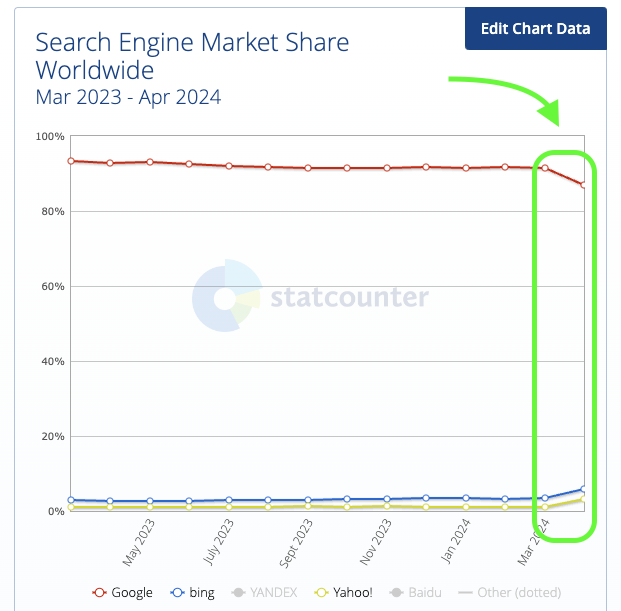 Screenshot from: https://gs.statcounter.com/search-engine-market-share/, May 2024.
Screenshot from: https://gs.statcounter.com/search-engine-market-share/, May 2024.Search Quality Concerns
Many industry experts have recently expressed concerns about the declining quality of Google’s search results.
A portion of the SEO community believes that the search giant’s results have worsened following the latest update.
These concerns have begun to extend to average internet users, who are increasingly voicing complaints about the state of their search results.
Alternative Perspectives
Web analytics platform SimilarWeb provided additional context on X (formerly Twitter), stating that its data for the US for March 2024 suggests Google’s decline may not be as severe as initially reported.
From our data (Search Engine website category, US, March 2024) it doesn’t look like we’re there yet: pic.twitter.com/RBUJp4ZLeb
— Similarweb (@Similarweb) May 1, 2024
SimilarWeb also highlighted Yahoo’s strong performance, categorizing it as a News and Media platform rather than a direct competitor to Google in the Search Engine category.
Don’t underestimate Yahoo. They’re doing great. On our platform they’re categorized as News and Media, and hence not a direct competitor to Google in the Search Engine category. But they rank #10 worldwide, #6 in the US, and #1 in their category. Much higher than Bing and OpenAI. pic.twitter.com/O4yJu5QEK6
— Similarweb (@Similarweb) May 2, 2024
At the same time, Google is slightly declining 👀 pic.twitter.com/9i7paeU1QG
— Similarweb (@Similarweb) May 2, 2024
Why It Matters
The shifting search engine market trends can impact businesses, marketers, and regular users.
Google has been on top for a long time, shaping how we find things online and how users behave.
However, as its market share drops and other search engines gain popularity, publishers may need to rethink their online strategies and optimize for multiple search platforms besides Google.
Users are becoming vocal about Google’s declining search quality over time. As people start trying alternate search engines, the various platforms must prioritize keeping users satisfied if they want to maintain or grow their market position.
It will be interesting to see how they respond to this boost in market share.
What It Means for SEO Pros
As Google’s competitors gain ground, SEO strategies may need to adapt by accounting for how each search engine’s algorithms and ranking factors work.
This could involve diversifying SEO efforts across multiple platforms and staying up-to-date on best practices for each one.
The increased focus on high-quality search results emphasizes the need to create valuable, user-focused content that meets the needs of the target audience.
SEO pros must prioritize informative, engaging, trustworthy content that meets search engine algorithms and user expectations.
Remain flexible, adaptable, and proactive to navigate these shifts. Keeping a pulse on industry trends, user behaviors, and competing search engine strategies will be key for successful SEO campaigns.
Featured Image: Tada Images/Shutterstock
SEO
How To Drive Pipeline With A Silo-Free Strategy

When it comes to B2B strategy, a holistic approach is the only approach.
Revenue organizations usually operate with siloed teams, and often expect a one-size-fits-all solution (usually buying clicks with paid media).
However, without cohesive brand, infrastructure, and pipeline generation efforts, they’re pretty much doomed to fail.
It’s just like rowing crew, where each member of the team must synchronize their movements to propel the boat forward – successful B2B marketing requires an integrated strategy.
So if you’re ready to ditch your disjointed marketing efforts and try a holistic approach, we’ve got you covered.
Join us on May 15, for an insightful live session with Digital Reach Agency on how to craft a compelling brand and PMF.
We’ll walk through the critical infrastructure you need, and the reliances and dependences of the core digital marketing disciplines.
Key takeaways from this webinar:
- Thinking Beyond Traditional Silos: Learn why traditional marketing silos are no longer viable and how they spell doom for modern revenue organizations.
- How To Identify and Fix Silos: Discover actionable strategies for pinpointing and sealing the gaps in your marketing silos.
- The Power of Integration: Uncover the secrets to successfully integrating brand strategy, digital infrastructure, and pipeline generation efforts.
Ben Childs, President and Founder of Digital Reach Agency, and Jordan Gibson, Head of Growth at Digital Reach Agency, will show you how to seamlessly integrate various elements of your marketing strategy for optimal results.
Don’t make the common mistake of using traditional marketing silos – sign up now and learn what it takes to transform your B2B go-to-market.
You’ll also get the opportunity to ask Ben and Jordan your most pressing questions, following the presentation.
And if you can’t make it to the live event, register anyway and we’ll send you a recording shortly after the webinar.
SEO
Why Big Companies Make Bad Content
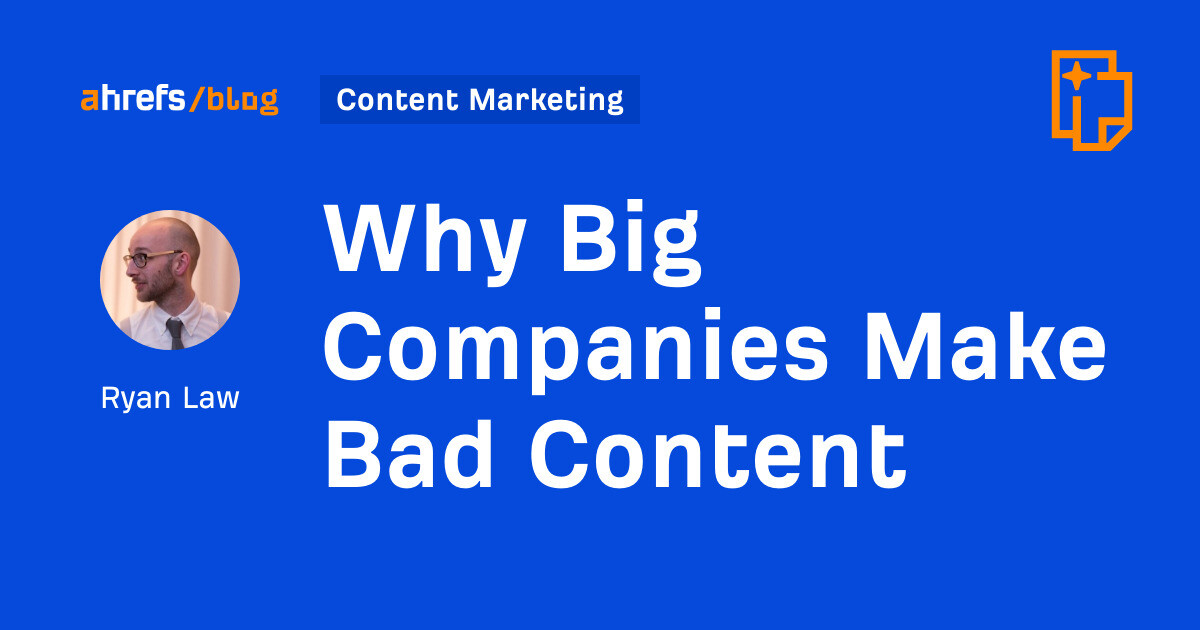
It’s like death and taxes: inevitable. The bigger a company gets, the worse its content marketing becomes.
HubSpot teaching you how to type the shrug emoji or buy bitcoin stock. Salesforce sharing inspiring business quotes. GoDaddy helping you use Bing AI, or Zendesk sharing catchy sales slogans.
Judged by content marketing best practice, these articles are bad.
They won’t resonate with decision-makers. Nobody will buy a HubSpot license after Googling “how to buy bitcoin stock.” It’s the very definition of vanity traffic: tons of visits with no obvious impact on the business.
So why does this happen?
There’s an obvious (but flawed) answer to this question: big companies are inefficient.
As companies grow, they become more complicated, and writing good, relevant content becomes harder. I’ve experienced this firsthand:
- extra rounds of legal review and stakeholder approval creeping into processes.
- content watered down to serve an ever-more generic “brand voice”.
- growing misalignment between search and content teams.
- a lack of content leadership within the company as early employees leave.


Similarly, funded companies have to grow, even when they’re already huge. Content has to feed the machine, continually increasing traffic… even if that traffic never contributes to the bottom line.
There’s an element of truth here, but I’ve come to think that both these arguments are naive, and certainly not the whole story.
It is wrong to assume that the same people that grew the company suddenly forgot everything they once knew about content, and wrong to assume that companies willfully target useless keywords just to game their OKRs.
Instead, let’s assume that this strategy is deliberate, and not oversight. I think bad content—and the vanity traffic it generates—is actually good for business.
There are benefits to driving tons of traffic, even if that traffic never directly converts. Or put in meme format:
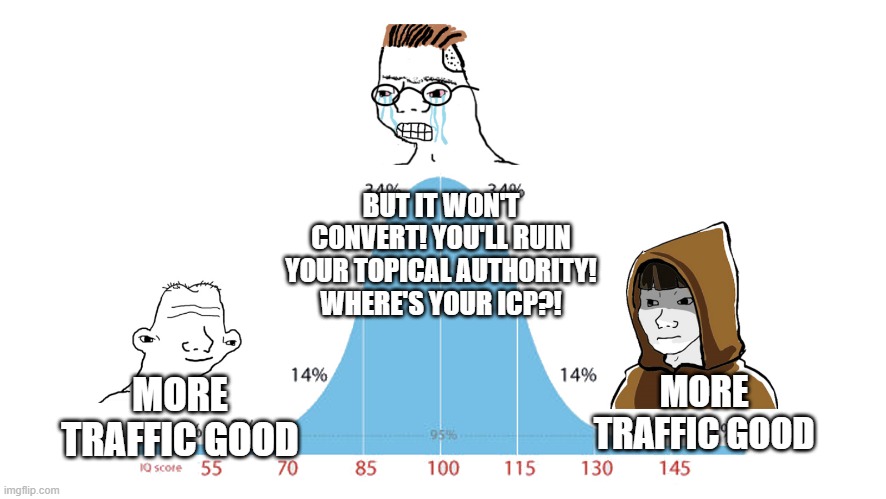

Programmatic SEO is a good example. Why does Dialpad create landing pages for local phone numbers?


Why does Wise target exchange rate keywords?


Why do we have a list of most popular websites pages?


As this Twitter user points out, these articles will never convert…
…but they don’t need to.
Every published URL and targeted keyword is a new doorway from the backwaters of the internet into your website. It’s a chance to acquire backlinks that wouldn’t otherwise exist, and an opportunity to get your brand in front of thousands of new, otherwise unfamiliar people.
These benefits might not directly translate into revenue, but over time, in aggregate, they can have a huge indirect impact on revenue. They can:
- Strengthen domain authority and the search performance of every other page on the website.
- Boost brand awareness, and encourage serendipitous interactions that land your brand in front of the right person at the right time.
- Deny your competitors traffic and dilute their share of voice.
These small benefits become more worthwhile when multiplied across many hundreds or thousands of pages. If you can minimize the cost of the content, there is relatively little downside.
What about topical authority?
“But what about topical authority?!” I hear you cry. “If you stray too far from your area of expertise, won’t rankings suffer for it?”
I reply simply with this screenshot of Forbes’ “health” subfolder, generating almost 4 million estimated monthly organic pageviews:


And big companies can minimize cost. For large, established brands, the marginal cost of content creation is relatively low.
Many companies scale their output through networks of freelancer writers, avoiding the cost of fully loaded employees. They have established, efficient processes for research, briefing, editorial review, publication and maintenance. The cost of an additional “unit” of content—or ten, or a hundred—is not that great, especially relative to other marketing channels.
There is also relatively little opportunity cost to consider: the fact that energy spent on “vanity” traffic could be better spent elsewhere, on more business-relevant topics.
In reality, many of the companies engaging in this strategy have already plucked the low-hanging fruit and written almost every product-relevant topic. There are a finite number of high traffic, high relevance topics; blog consistently for a decade and you too will reach these limits.
On top of that, the HubSpots and Salesforces of the world have very established, very efficient sales processes. Content gating, lead capture and scoring, and retargeting allow them to put very small conversion rates to relatively good use.
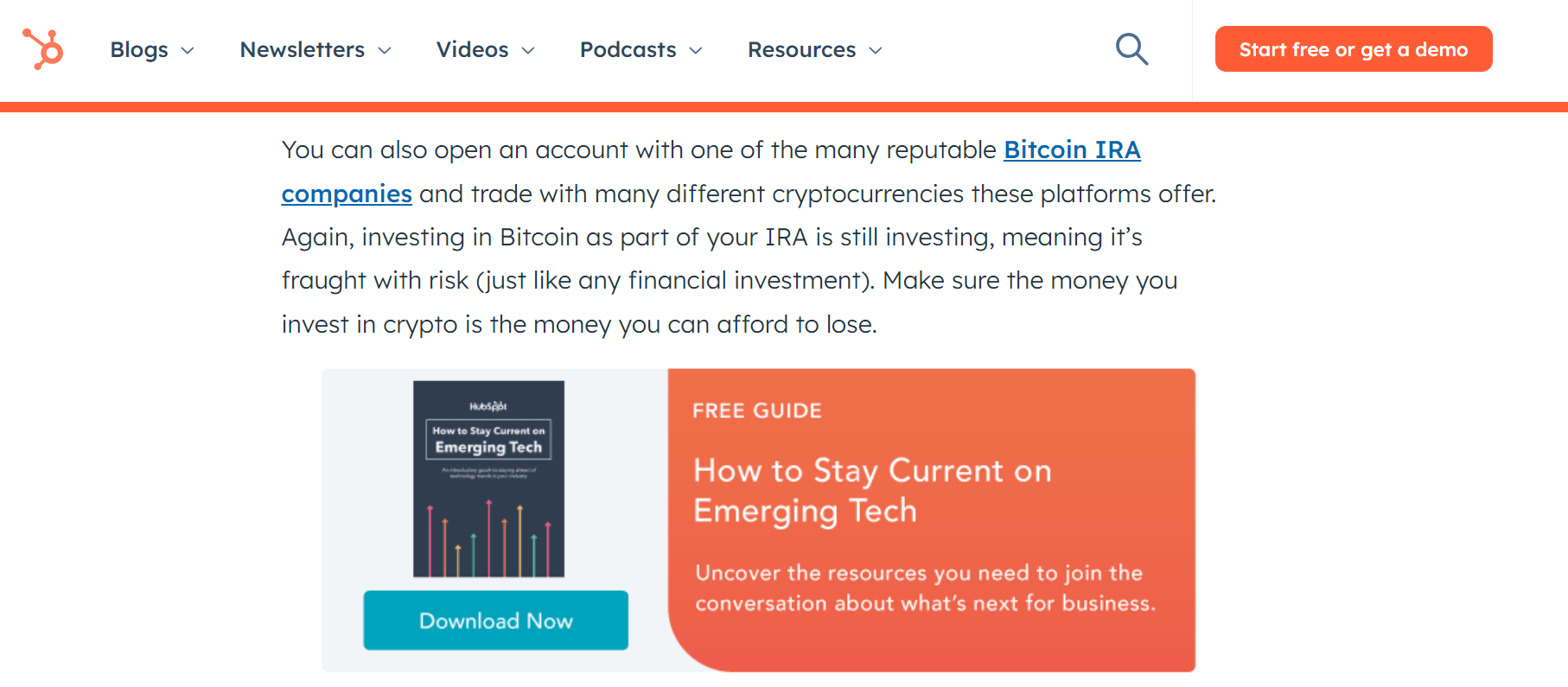

Even HubSpot’s article on Bitcoin stock has its own relevant call-to-action—and for HubSpot, building a database of aspiring investors is more valuable than it sounds, because…
The bigger a company grows, the bigger its audience needs to be to continue sustaining that growth rate.
Companies generally expand their total addressable market (TAM) as they grow, like HubSpot broadening from marketing to sales and customer success, launching new product lines for new—much bigger—audiences. This means the target audience for their content marketing grows alongside.
As Peep Laja put its:
But for the biggest companies, this principle is taken to an extreme. When a company gears up to IPO, its target audience expands to… pretty much everyone.
This was something Janessa Lantz (ex-HubSpot and dbt Labs) helped me understand: the target audience for a post-IPO company is not just end users, but institutional investors, market analysts, journalists, even regular Jane investors.
These are people who can influence the company’s worth in ways beyond simply buying a subscription: they can invest or encourage others to invest and dramatically influence the share price. These people are influenced by billboards, OOH advertising and, you guessed it, seemingly “bad” content showing up whenever they Google something.
You can think of this as a second, additional marketing funnel for post-IPO companies:


These visitors might not purchase a software subscription when they see your article in the SERP, but they will notice your brand, and maybe listen more attentively the next time your stock ticker appears on the news.
They won’t become power users, but they might download your eBook and add an extra unit to the email subscribers reported in your S1.
They might not contribute revenue now, but they will in the future: in the form of stock appreciation, or becoming the target audience for a future product line.
Vanity traffic does create value, but in a form most content marketers are not used to measuring.
If any of these benefits apply, then it makes sense to acquire them for your company—but also to deny them to your competitors.
SEO is an arms race: there are a finite number of keywords and topics, and leaving a rival to claim hundreds, even thousands of SERPs uncontested could very quickly create a headache for your company.
SEO can quickly create a moat of backlinks and brand awareness that can be virtually impossible to challenge; left unchecked, the gap between your company and your rival can accelerate at an accelerating pace.
Pumping out “bad” content and chasing vanity traffic is a chance to deny your rivals unchallenged share of voice, and make sure your brand always has a seat at the table.
Final thoughts
These types of articles are miscategorized—instead of thinking of them as bad content, it’s better to think of them as cheap digital billboards with surprisingly great attribution.
Big companies chasing “vanity traffic” isn’t an accident or oversight—there are good reasons to invest energy into content that will never convert. There is benefit, just not in the format most content marketers are used to.
This is not an argument to suggest that every company should invest in hyper-broad, high-traffic keywords. But if you’ve been blogging for a decade, or you’re gearing up for an IPO, then “bad content” and the vanity traffic it creates might not be so bad.
-

 WORDPRESS6 days ago
WORDPRESS6 days ago9 Best WooCommerce Multi Vendor Plugins (Compared)
-

 SEO6 days ago
SEO6 days agoGoogle March 2024 Core Update Officially Completed A Week Ago
-

 SEARCHENGINES6 days ago
SEARCHENGINES6 days agoGoogle March 2024 Core Update Finished April 19, 2024
-

 MARKETING5 days ago
MARKETING5 days agoNavigating the Video Marketing Maze: Short-Form vs. Long-Form
-
![The Current State of Google’s Search Generative Experience [What It Means for SEO in 2024] person typing on laptop with](https://articles.entireweb.com/wp-content/uploads/2024/04/The-Current-State-of-Googles-Search-Generative-Experience-What-It.webp-400x240.webp)
![The Current State of Google’s Search Generative Experience [What It Means for SEO in 2024] person typing on laptop with](https://articles.entireweb.com/wp-content/uploads/2024/04/The-Current-State-of-Googles-Search-Generative-Experience-What-It.webp-80x80.webp) MARKETING6 days ago
MARKETING6 days agoThe Current State of Google’s Search Generative Experience [What It Means for SEO in 2024]
-

 SEO7 days ago
SEO7 days agoGoogle Declares It The “Gemini Era” As Revenue Grows 15%
-
SEARCHENGINES5 days ago
Daily Search Forum Recap: April 26, 2024
-

 WORDPRESS6 days ago
WORDPRESS6 days agoNew WordPress.com Themes for April 2024 – WordPress.com News






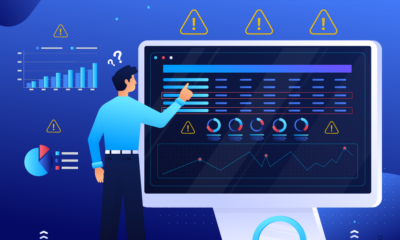

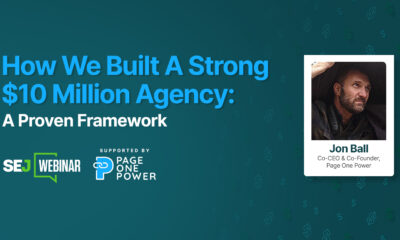







You must be logged in to post a comment Login